Biscuits, Part 1
A recipe for the best biscuits I've ever eaten.
The first memorable biscuit I ever ate was on a farm somewhere in Tennessee. This was almost ten years ago, in 2016. My buddy Ben and I came to the farm from Nashville. We were at the tail end of a two-week, fried-food and booze-soaked road trip from the Bay Area to Chicago1.
That morning, we’d driven slowly over meandering, rolling hills of tobacco — deep greens stained with patches of death yellow. It was a hot, late-summer's day. We passed smokehouses, towering black walnut trees that waved in the gentle breeze, cotton clouds hung around a soft blue sky. We inhaled the taste of the Southern country with our eyes, the sun with our skin.



When we arrived at the farm, our host — the mother of one of Ben’s friends — gave us a tour, before leaving us to our own devices. We drove an ATV through their private meadow, said hello to some goats. Then, we headed back to the house. Our host ran a small biscuit company, and we came back to find her cranking out bulk biscuits from the small commercial kitchen on her property. She offered to let me and Ben help with the biscuits. We excitedly accepted.

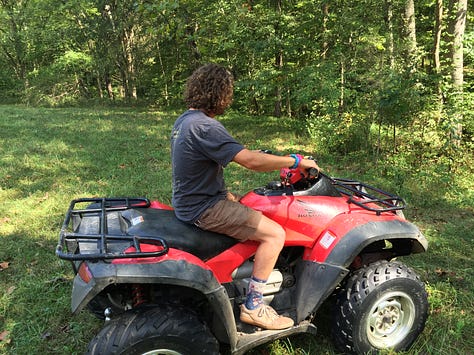
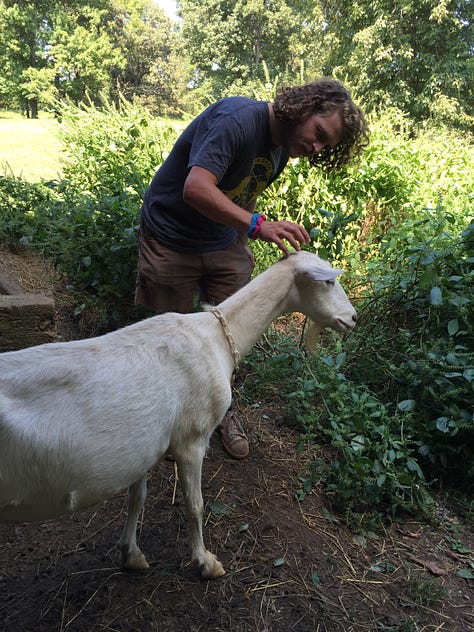
Her biscuit recipe was pretty straightforward: we mixed a big batch of dry ingredients together, then into that, we quickly incorporated many quarts of half and half. That was it — I don’t believe there was any butter in the biscuit dough, just flour, some leavening agent, and liquid dairy (making them not so different from “drop” or “emergency” biscuits). She formed the dough into a large rectangle, then cut that down into many massive, square biscuits. Ben and I were then tasked to submerge each square biscuit into saucepans full of blisteringly hot melted butter. We were meant to do this by hand, and I remember looking at Ben, confused and in pain: was it supposed to hurt so much? I muffled my whimpers (story of my life…), and continued dipping biscuits, my fingers screaming in the hot fat. Once we’d finished, the biscuits (along with any of my epidermis that may have melted off) were baked until deep golden brown.
She gave us each a hot one to try, straight out of the oven. Wow. It must have been the first fresh, homemade biscuit I’d ever had. And it was amazing. All of the beauty that surrounded us in that moment — the green rolling hills and warm blue skies and gentle blowing trees — seemed to be contained in, or maybe completed by, the experience of eating these biscuits. Hot biscuits and country comfort — they belonged together, and they nuzzled into my brain side-by-side, all warm and tender, crisp and soft, easy-breezy and absolutely wonderful. Biscuits, I realized then, are one of the good things in life.
As we started on the next batch of biscuits, however, the peaceful illusion of our present circumstances started to fade, as it often can in the South. I noticed that InfoWars (a show I’d heard of but at that point had never actually heard) was playing softly in the background of the kitchen. What…was all the garbage this man was saying? Soon, our host started talking about the dangers of “muslim terrorists” in our country. Out here in rural Tennessee, huh? I sighed and, perpetually unable to hold my tongue, I engaged our host in what can only be called an argument. Before long, I’d worn out our welcome. We stuffed a few biscuits into our backpacks, and hit the road, heading North.
Though potentially scarring me for life in more ways than one, these bigot-borne biscuits formed a baseline for how big a blessing these buttery boys could be2. Not growing up in the South or in a family with really any connection to the South, my biscuit consumption for the first half of my life was mostly limited to fast food or occasional diner breakfasts. The McDonald’s biscuit, though nostalgic, I knew to be crumbly and pasty; the Popeyes biscuit was buttery and crunchy enough to make my brain happy, but in its wake left only a gesture toward a deeper world of possibilities; at diners, I’d mostly had stodgy, dense biscuits smothered in thickly off-white and speckled gravy — all too much with no reprieve from the richness. I didn’t like these biscuits much, and to be honest, I don’t think I really like biscuits and gravy (though I’m always willing to be proven wrong and turned on to an opinion-changing spot…). It might seem like an obvious realization, but when I had that hateful lady’s big Tennessee biscuits, I could see that most of the biscuits I’d had in the past were some failed, bastardized attempt at replicating the beauty of a hot, fresh, homemade southern biscuit. I logged this remarkable biscuit as a data point, keeping it tucked away for future biscuit exploration and… maybe even preparation?
After my and Ben’s road trip, biscuits didn’t rejoin the chat of my life until five years later, in 2021. I was living in a Brooklyn that was still mostly shut down from the Pandemic. At the time, my buddy Matt and I would frequently have cooking-centric hang-outs as we worked on an idea for a narrative cooking short film. On one such occasion, I decided — I can’t remember why — to make biscuits. I was hopeful, with the memory of the big Tennessee biscuits in my mind’s eye. But for some reason, I had decided to try making the biscuits without a recipe. It... didn’t go well. I vaguely remember them looking like hard, melted scones. Not so good. Yesterday, I asked Matt if he remembered what they were like. He said they were “very dense and tough…sort of like little biscuit rocks.” Sounds about right.
My next attempt to make biscuits came a few years later, when I was living in El Cerrito, California, and working at Chez Panisse. On my own time, I’d been diving deeper into my interest in the cooking of the American South. I was buying local cornmeal to make cornbread and johnny cakes, attempting new (to me) preserves like marmalade and sugared raspberries. Eventually, inevitably, I decided to made biscuits. Remembering my previous failure, I followed an Edna Lewis recipe — making my own baking powder (by sifting together baking soda, cream of tartar, and cornstarch), mixing soft lard into dry ingredients to create a wet-sand-like consistency, and binding that with liquid dairy. Not having anything resembling a biscuit cutter, I cut out small biscuits with a thick-lipped, Chez Panisse water glass.
I didn’t understand why I was doing any of the steps; I just followed them and trusted. Still, now a professional cook, I was feeling confident. I had friends over at the time and I’m sure I even said something like, “get ready for some homemade biscuits, fellas — man, I love you guys…” In the end, though, the biscuits…well, boys, they sucked. They had no rise, they were not tender, nor flaky nor layered. They were thin, crackery pucks. It was not Ms. Lewis’ fault, I was sure, but my own. To be fair, the biscuits weren’t horrible, and they were even quite enjoyable stuffed with some Straus Vanilla Chocolate Chip ice cream, but they were nothing like the big, handsome, layered beauties I was aiming for. All in all, another failure.


I slunk into my next shift at Chez Panisse feeling down on my biscuits3. I shared my failure with Chef Nathan — Nathan Alderson, one of the two long-term chefs of the Chez cafe, and a Kentucky-raised food lover with incredibly deep knowledge and strong opinions on Southern food. I explained my process and results. He said something like “Hm, that’s strange.” and then: “we’ll make them together sometime.” I was floored. Honestly, it was one of the most exciting sentences I’d heard uttered in that restaurant (up there with “there’s mulberries in the Pastry walk-in” and “Kadota figs came in,” and “I put your shift beer in a carafe”... I guess there were a lot of good sentences there…). The idea of having Nathan’s attention focused on teaching me how to make biscuits was thrilling. The chefs at Chez often times end up in a managing role, making sure other people are getting their work done, helping people that are behind, or banging out big, more complicated prep projects for service (smoking black cod, picking crab, etc.), and the pace of restaurant work is very busy, so there wasn’t a lot of time for them cook extracurricular food or share off-topic lessons.
But, a few days later, we had an unusually slow day of prep. Nathan said it was time to make biscuits. I immediately told everyone the news, calling upstairs (on the phone that connected the downstairs prep kitchen to line where service happened) to the busy line cooks:
“Hello?”
“Nathans making biscuits!!!”
“...What?”
“It’s Cody!”
“Right, do you need something?”
“Nathan’s making biscuits!!!”
“...Okay…”
Everyone loved me at Chez. This was going to be the best prep shift ever! I stuck by Nathan as he got to work on the biscuits, all the while absent-mindedly working on my own cooking projects. The first thing he told me was: everything has to be very cold. In a hot, active restaurant kitchen, this isn’t the easiest task. So, between every step in the biscuit-making process, he’d pop the ingredients into the fridge for 10-15 minutes to cool down. For example: he’d measure his dry ingredients, whisk them together, and put them in the fridge; then, he’d cut his butter into bits, and put those in the fridge; then, he’d smush the butter into the flour, put it in the fridge; then, he’d mix the buttermilk into the buttered flour, then put that in the fridge.
The next thing he told me was: the dough must not be overworked. So, when he added the buttermilk, he mixed everything together minimally and very gently. Once the dry ingredients were almost fully incorporated, he dumped the dough onto a work surface, and kneaded it all together so quickly and briefly that you could have missed it if you’re a long blinker. Then, he cut his biscuits out, folded the scraps together once (and only once), cut out another biscuit or two, and popped those formed biscuits into the fridge. Then, he took them out, pricked them twice with a fork, coated them with egg wash, and put them in the oven. I hurriedly wrote down as many steps as I could, underlining the two biggest lessons: cold / don’t overwork!!
What emerged from the oven were the best biscuits I’ve had in my entire life, to this very day, and likely until my untimely death. He served them forth with thick slices of salted butter and a jar of crabapple jelly. I watched him prepare his own: he pricked the sides a few times with a fork, and pried it in half, hamburger style. Then, he slid in two or three large wedges of butter, and a large dollop of jelly, before closing the lid tightly. I did the same. I took a bite: crunch! Then, softness, cold butter oozing at the edges with slightly warmer melted butter melding into thick tart sweet jelly before SALT and more crunch. My brain did the equivalent of a Hitchcock zoom as the biscuit entered my body. Just amazing. Crunchy soft butter tang light incredible tender salty sweet sticky magic. Beyond words, really. Simply: it was one of the best things to ever pass through the gates of my teeth castle. Perfect. Classic. Uncomplicated. Pure Joy.
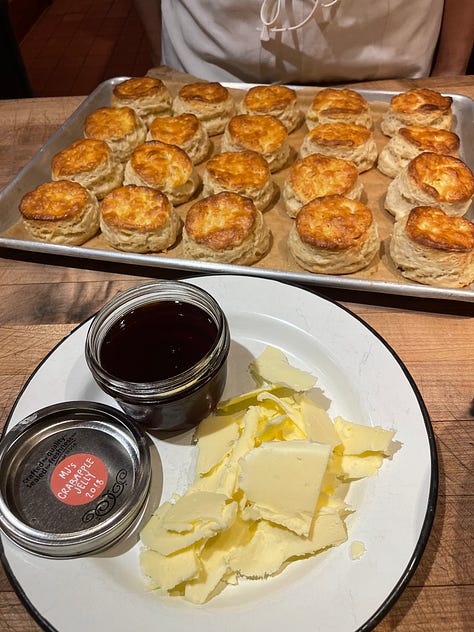


Nathan’s Incredible Biscuits
Yield: 6 smaller or 4 big boys
*Important: all ingredients should be cold when you start. Nathan pops everything into the fridge in between each step to keep things cold.
Dry Ingredients (whisked together in a bowl):
2 cups flour (ideally half all-purpose, half 00 flour, though entirely all-purpose is fine, too)
1 tablespoon baking powder
1 teaspoon salt
black pepper
pinch of sugar
Wet Ingredients:
⅓ cup cold unsalted butter (cut into 1/8-1/4 inch cubes)
1 cup buttermilk (can sub milk if you don’t want to buy)
Egg
Water
Process:
Into the dry ingredients, slowly pinch and smear in the butter until it becomes little uneven chunks of smushed and buttered flour, surrounded by some dry flour.
Then, add most of the buttermilk, holding a little back — you don’t want it to be too wet.
Mix roughly (can use a fork) until it is clumpy and shaggy, like over-cooked, dry scrambled eggs. Add a little more liquid until there’s no completely dry flour.
Potentially Clarifying Note: It’s wet and dry at the same time (this is something I wrote at the time so I am keeping it in, even though it is unclear). The dough starts to form into larger globs with noticeable butter chunks throughout. Still shaggy, though, not completely homogenous. The texture is kind of pull-apart-y, like cooked brioche.
Flour your board or work surface. Tip the dough out onto the board, sprinkle some flour on the dough, and knead it well 4-5 times (don’t over mix, just enough to bring together).
Press the dough out with your hands into a ½ inch thick rectangle, do not use a rolling pin!
Cut out your biscuits (using a thin biscuit cutter pressed straight down — do not twist the cutter as or after you cut).
Place the biscuits, nearly touching, on a parchment lined baking sheet. Put two fork pricks in each,
Scramble an egg with a tablespoon of water and brush the top of the biscuits with a bit of egg wash.
Sprinkle with more pepper, if you like.
Bake at 425-50 for 12-15 minutes, until nicely golden on top. Enjoy with lots of butter and jam.
I have made these biscuits many times since Nathan showed me the way. The first time, they ended up a bit blonde, and a bit overworked. The next time, I nailed it, and went on to make batches every few weeks: for breakfast sandwiches (stuffed with my Crispy Peeled Potato Omelette with pepperoni and mozzarella, or a CPPO with bacon and American cheese plus homemade orange marmalade), to impress dates, as an incredible angel food cake substitute topped with strawberries and whipped cream. Nathan’s biscuits are amazing. You have to make them.
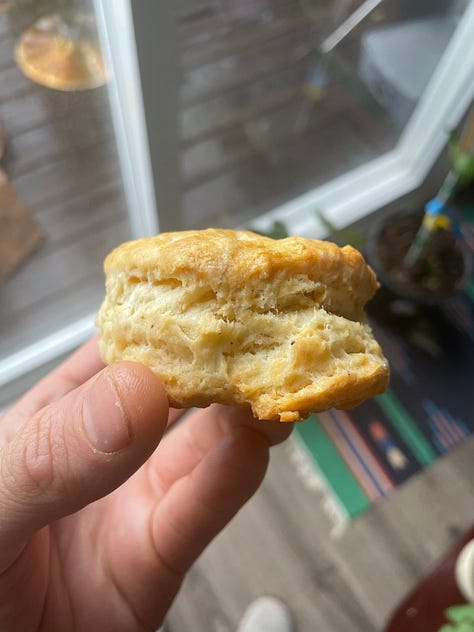
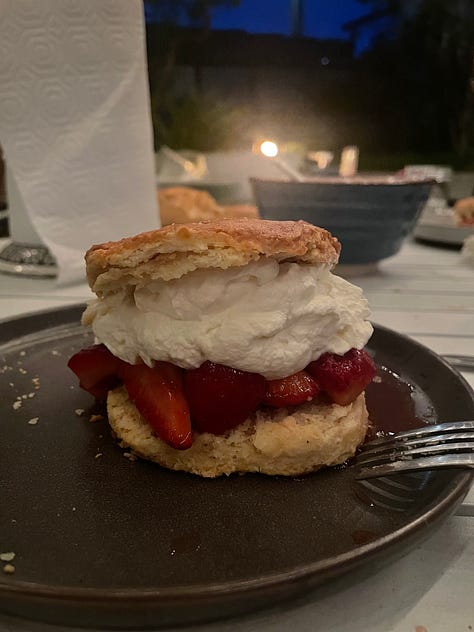
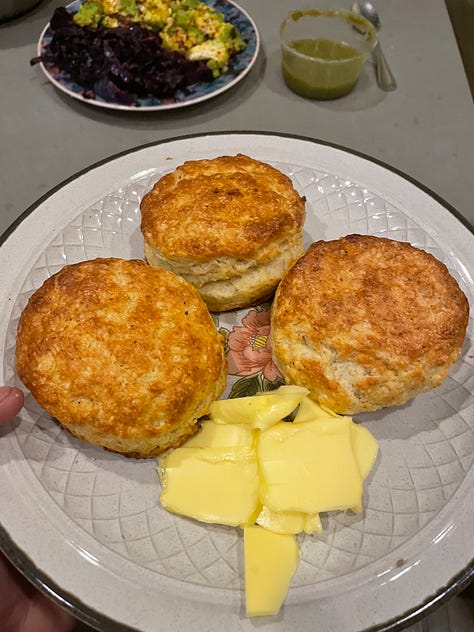
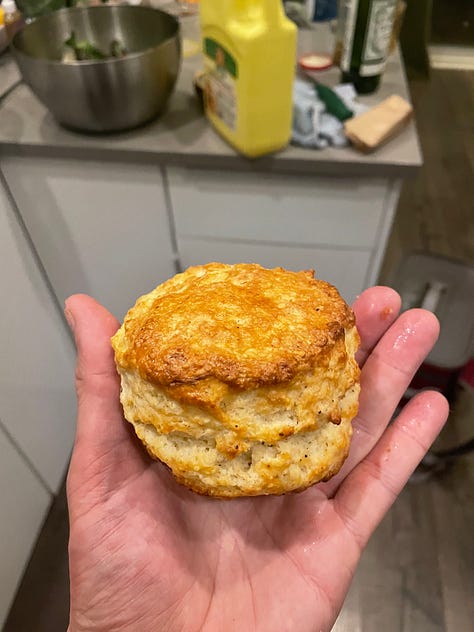

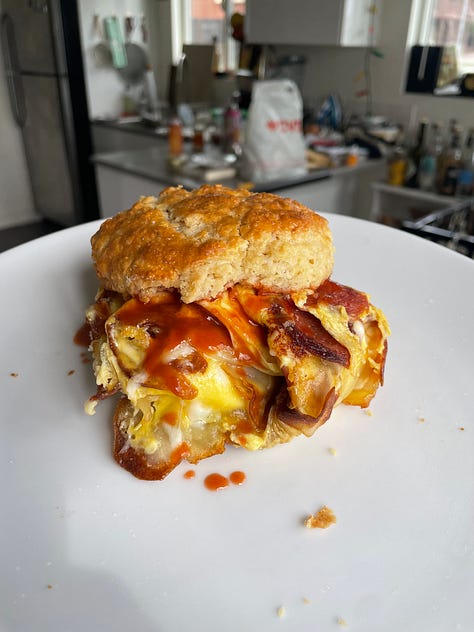
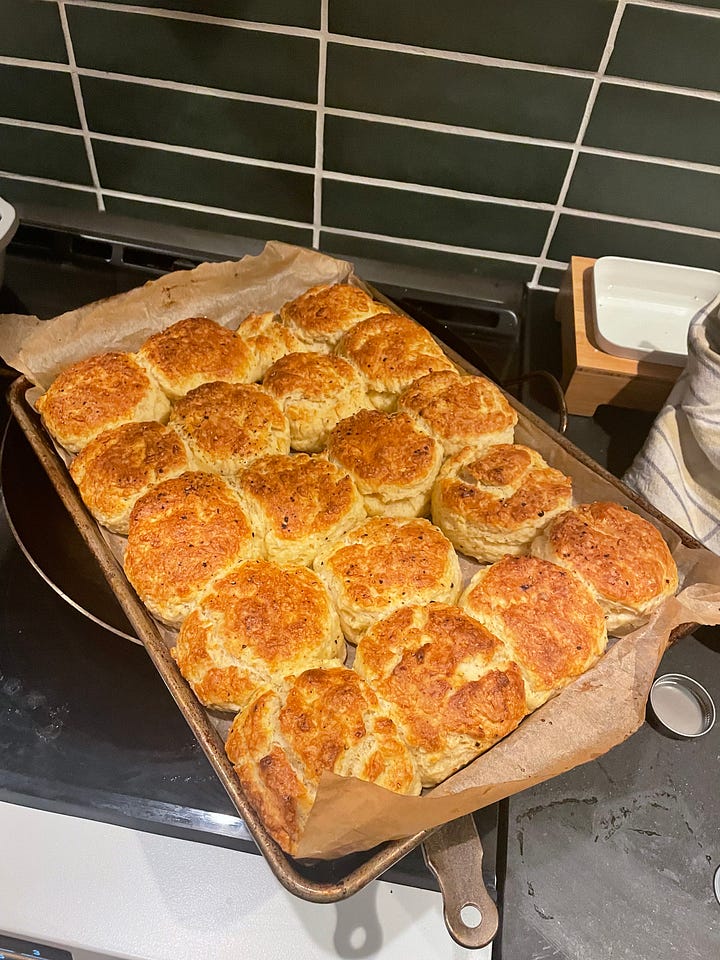

The fucked up thing for you is the following: it’s getting late, this story is basically due right now, and I have a lot more to share with you about biscuits. I’ve got tips, clarifying biscuit theories, and several more recipes for you. The recipe I put down for Nathan’s biscuits… it needs more information. And I have that information. And I think, I hope, it will make you much better and more aware biscuit makers. But for now, I leave you simply with Nathan’s recipe above, and encourage you to give it a try this week. In two weeks, I will return with the much needed second half of this biscuit journey. We’ll try making some more biscuits then, see if we can really dial them in. Oh, and go ahead and buy a quart of cultured buttermilk to make your first batch. Hold on to it, you’ll need it in a couple weeks for your next round of biscuits, and more.
Happy eating,
Cody
Biscuit’s Part 2, Coming May 19th.
We'd come in “the Taco,” a 1994 Toyota Pickup — candy apple red with a leaky white camper shell, a beer tap handle as the stick shift knob, and a two-level bed set-up Ben had built in the back — we’d bought for $1,500 in order to drive from California (through Burning Man, Utah, and NoLa) to Chicago. That trip holds many stories waiting to be written about, but for our current purpose, Ben and I are in Tennessee, visiting a farm run by one of Ben’s friend’s moms.
Sigh.
“Down on my biscuits” sounds like an old-timey turn of phrase: "I'm down on my biscuits, I just need a small loan!" ……. so yeah, hey I’m so sleepy.



Enjoyed reading this latest cooking adventure!
Next time you’re in Austin my partner and I will make you some biscuits with sausage gravy that’ll fix your opinion… but if that feels too threatening to follow through on it’s just bourdain’s recipe from appetites!